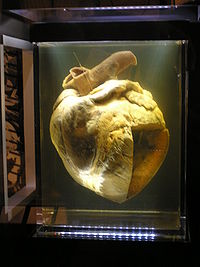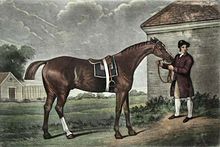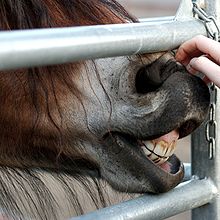- Circulatory system of the horse
-
 The heart of the great racehorse Phar Lap.
The heart of the great racehorse Phar Lap.
The circulatory system of the horse consists of the heart, the blood vessels, and the blood.
Contents
Anatomy of the circulatory system
The heart
The equine heart is made of muscle tissue, more rounded in shape than a human's, built with the sole purpose of pumping blood throughout the body. It consists of 4 chambers: the left and right atria, and the left and right ventricles.
The average adult horse has a 3.6 kg (8.5 lb) heart, although it can be more than twice this size (see "The X-factor" below). The heart grows until the horse is 4 years of age, although it can increase slightly in size with proper conditioning work. Heart size does not necessarily correlate to the size of the horse.[1]
The blood and blood vessels
Blood is made up of red blood cells (erythrocytes) and white blood cells (leukocytes), as well as plasma. Produced in bone marrow, red blood cells are responsible for carrying oxygen to tissue and removing carbon dioxide, all via hemoglobin. White blood cells are used for defense against pathogens in the immune system. Plasma suspends the blood cells, contains clotting factors, and contributes to the greatest volume of blood.
The heart and blood vessels contain approximately 34 Litres of blood in a 450 kg horse (9 U.S. gallons in a 1000 lb). Which equates to about 76 cc/kg (1.2 oz/lb)[2]
The spleen
The spleen removes damaged red blood cells from circulation. It also holds extra blood cells, releasing them during exertion to increase blood volume and the amount of oxygen transported to tissues.
The frog
Main article: Frog (horse)Each hoof contains a structural component known as the "frog," which covers the deeper structure of the hoof known as the digital cushion, a vessel-filled tissue. When the horse places weight on a leg, the ground pushes upward on the frog, compressing it and the underlying digital cushion. This results in squeezing blood out of the digital cushion, which then helps to pump it back up the leg, helping the heart to work against gravity.
Pulse
The average pulse is 28-45 beats per minute (bpm) in a mature horse, but it can reach more than 250 bpm during maximum exertion. This drops significantly within 15–30 seconds after the horse stops galloping. A 2-year-old horse may have a slightly faster pulse, and a 2-4 week old foal normally has a pulse between 70-90 bpm.[2] Heart rate may also increase when the horse is excited, overheated or suffering severe dehydration, has a fever, has an infection or septicemia, has experienced a great deal of blood loss, has advanced heart or lung disease, or is in shock. In these cases, the resting heart rate may be above 80 in an adult animal. When the heart rate is below 20, the horse may be hypothermic, or have pressure on the brain, heart disease, or collapsed circulation.[2]
Determining heart rate
Heart rate may be determined with a stethoscope, placed just behind the left elbow of the animal. The pulse may also be felt when taken on an artery close to the skin, most commonly the facial artery located on the lower jaw just behind the cheek. The radial pulse may be taken right behind the back of the knee. The digital pulse is taken on the inside of the pastern, right below the fetlock. It is usually very faint and difficult to find, although certain problems, such as laminitis, will make it quite strong.
Blood pressure
Although blood pressure may vary greatly between animals, the average blood pressure for a standing horse is 120/70 mmHg. An indirect measurement of blood pressure may be taken with a cuff placed around the middle coccygeal artery at the base of the tail, or above the digital artery. It is usually taken to monitor circulation during surgery.[2] Direct blood pressure measurements, via catheterization of an artery provide a more accurate measurement, and are preferred for anesthetic monitoring.[3]
The gums
The gums of the horse can offer good clues in his circulatory heath. The owner can assess the gums by lifting the upper lip with one hand, while holding the head still (via halter) with the other.
Gum color
- Pale pink: the healthy color of gums, indicates good circulation. May brighten slightly after stenuous work due to an increase in circulation.
- Very pale pink: due to contracted capillaries. May indicate anemia, fever, or blood loss.
- Pale blue, gray, or whitish: indicative of anaemia (low red blood cell count). May indicate severe shock or illness. A serious sign, often the best option is to call the veterinarian.
- Yellow with a tinge of brown: indicates jaundice and liver failure. Very serious and the veterinarian should see the animal immediately.
- Yellowish: a bright yellow tinge may occur if the horse has high levels of beta-carotene in his diet, such as horses that eat a good deal of alfalfa hay. Does not indicate any serious problem.
- Dark red: indicates enlarged capillaries, due to poisoning or severe dehydration. The veterinarian should be contacted immediately.
Capillary refill time
The capillary refill time is determined by pressing a finger against the horse's gums for about 2 seconds, so that a white "thumbprint" is left. After releasing, it should take no longer than 2 seconds for the gum color to return to normal. If it takes longer for the gum color to return, the horse may be experiencing shock.
The "X factor"
 Eclipse, the horse to whom the X factor has been traced
Eclipse, the horse to whom the X factor has been traced
The X factor is a gene found on the x-chromosome of horses that causes a larger than average heart. It is commonly traced back to certain high-performance Thoroughbred, Quarter Horse, and Standardbred racehorses. It was first documented in Eclipse, known as an excellent broodmare producer, at 6.4 kg (14 pounds). A large heart was also seen in Phar Lap (6.4 kg/14 lb), Sham (8.2 kg/18 lb), and Secretariat (estimated at 10 kg / 22 lb). It is also thought that the great producing mare Pocahontas was homozygous for the X factor. Large hearts have been traced back to four lines (all descendants of Eclipse): those of Princequillo, War Admiral, Blue Larkspur and Mahmoud.[1]
Because the X factor is found only on the x-chromosome, it may only be passed to a stallion's daughters, or to a colt or filly via his dam. This may explain why Secretariat had daughters that were better performers on average than his sons. Today, the hearts of racehorses are scored on a scale, and a high heart score can increase the animal's worth in some circles. That being said, poor training, conformation, or attitude can make even the most talented athlete perform poorly.[1]
Disorders of the circulatory system
- Anemia
- Arrhythmia
- Heart disease
- Heart failure
External links
References
- ^ a b c Marianna Haun. The X Factor: A matter of heart. Accessed July 2007.
- ^ a b c d Giffin, James and Tom Gore, DVM. Horse Owner's Veterinary Handbook, Second Edition. Howell Book House. New York, NY. Copyright 1998
- ^ Muir, Hubble (1991) Equine Anesthesia, Mosby, ISBN 0801635764
Categories:- Horse anatomy
Wikimedia Foundation. 2010.

